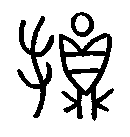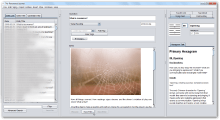There are just two ‘outer mountain’ hexagrams in the Upper Canon: 41, Decreasing, and 52, Stilling.
Hexagram 41, Decreasing
The Oracle
Hexagram 41 is Sun 損: decrease, damage, harm, weakening. So the words of the oracle that define it are startling –
‘Decreasing has truth and confidence.
Hexagram 41, Oracle
From the source, good fortune.
Not a mistake, there can be constancy.
Fruitful to have somewhere to go.
How to use this?
Two gui-bowls may be used for the offering.’
損有孚 – decrease has – or is – fu, truth and confidence, the state of rapport and spiritual connection. That’s quite a radical assertion. It brings good fortune from the source; it does not mean anything is wrong or broken; with this open channel to the spirits, it supports the enduring connection of zhen, constancy.
All this is possible because this decrease also means offering up. It’s a kind of emptying out that clears the channel. (LiSe says succinctly that Decreasing’s space is what makes the book better than the film, because it leaves room for your imagination.)
It opens a space for future developments, too. It’s fruitful to have somewhere to go – to have a reason for the offering, and to be outward-looking: focussed not on what you’re giving up, but on what’s next.
This attitude is the perfect opposite of Hexagram 23, where it’s ‘fruitless to have somewhere to go.’ Stripping Away is not the time to think about why this is happening or where it might lead – you just have to undergo the loss completely, and then may come a time to think about moving on. (With 24, Returning – which is the nuclear hexagram of 41.)
The offering needs only two gui. These are bronze bowls, probably originally modelled on a bamboo basket, used for grain offerings. All the examples I’ve found online, including those with inscriptions marking their importance, are less than a foot tall. In other words, this is a modest, undramatic, affordable offering.
Where’s the mountain?
It’s not so hard to see the lake in Hexagram 41. Its name, to begin with, shows a round vessel –

– that we could say is like a lake. Though of course, there are hexagrams (18, 42, 50) with vessels in their names but no lakes attached; Yi is a lot more than the sum of its trigrams.
And then there are those gui tureens in the Oracle text, also somewhat lake-like. And since dui means not only lake but also a fertile marsh or even a rice paddy, vessels specifically for grain offerings are a very good fit.
So where’s the mountain? I think it’s in the idea of offering up, a destination for our offering – really, just the sense that there is another dimension beyond the decrease and weakening, a ‘somewhere to go’. Mountains are sacred, after all. And then fu, ‘truth and confidence’, lies in the relationship between lake and mountain – which makes me imagine the mountain reflected in the lake.
The Image
The Image authors have a very clear sense of what this mountain does:
‘Below the mountain is the lake. Decreasing.
Hexagram 41, the Image
A noble one curbs anger and restrains desires.’
It ‘curbs and restrains’. This is definitely one of those ‘lid’-like mountains, containing and blocking – only now, the noble one is using it himself, for deliberate self-control. The great distance between mountain and lake lets the noble one separate his sense of himself from his emotions – a development from the ‘place to stand’ of 27’s mountain.
(In the context of the Sequence, this isn’t just a picture of repression, though: it’s practice to deepen emotional capacity. The lake that forms under the mountain in 41 will be put to good use out in the world in hexagrams 43, 45 and 49.)
How is this a picture of decrease? Tradition says that what is below is diminished to the benefit of what’s above (following the idea that Hexagram 41 is formed when the yang third line of 11 moves up to the sixth place): the lake evaporate and enriches the mountain.
Only… I can’t help thinking that in practice, surely, if there’s a lake at the foot of the mountain, the mountain is probably feeding the lake, not diminishing it. It might be fed by mountain streams, or prevailing winds may mean this is the rainy side of the mountain. As I suggested in my book, this could be a picture of mutuality: evaporating water from the lake greens the mountain; the mountain creates the lake basin.
What is decreased, in this picture, is movement. Water naturally flows, but here it’s gathered and contained. The noble one’s emotional volatility is decreased. Social interaction might be diminished, too – shrunk down to essentials.
Instead of movement, we get space for reflection: a ‘lid’ mountain containing and creating the lake below.
Hexagram 52, Stilling
The final outer mountain comes joined with an inner mountain, in Hexagram 52, Stilling. Mountain is the opposite of lake, so this is not about separating and reflecting – it’s exactly not an inner dialogue.
‘Stilling your back,
Hexagram 52, the Oracle
Not grasping your self.
Moving in your courtyard,
Not seeing your people.
Not a mistake.’
You’re not ‘grasping’ or not catching yourself – the same verb that would be used for catching game in a hunt, or capturing a fugitive. The character contains a dog for hunting, and a hand catching a bird –

You don’t catch yourself like a hunted animal, and you don’t see your people in your courtyard. The perfect parallelism of this text evokes the hexagram’s two mountains: inside, your back and your body, not captured; outside, the space where you live, without connection or conversation. Inner and outer worlds are both Stilled and quiet – and, the oracle says, this is no mistake.
The Image –
‘Joined mountains. Stilling.
Hexagram 52, the Image
A noble one in his thoughts does not leave his place.’
– says that the mountains are 兼 jian: combined, joined, concurrent, doubled. The noble one is thinking, not acting, and his thoughts are like the mountain – contained, secure, within the outer mountain that defines ‘his place’.
So there is joined stillness, inside and out. The contrast with 41, where the outer mountain puts a lid on roiling inner emotions, is emphatic: the noble one now is joined, not split.
Does this tell a story?
We’ve come a long way from Hexagram 4, where the mountain covered, protected and mentored the young fool. Is there a story we could tell with these hexagrams? Probably there are many… but one that occurs to me is a journey from separation towards unity. There’s the young fool and the sage, and ‘nurturing character’ (in hexagrams 4 and 18); then mountain-mindset lets the noble one see the limits of enlightened government in 22, and by 26 he’s teaching himself. From there, 27’s mountain can be a standpoint for self-awareness; 41’s, a means of self-control. And it culminates at 52, with inner and outer selves joined together.
…and in readings?
When your reading has an outer mountain, it may help to think about…
A lid – what there is in the situation that stops/hinders you, and whether that might not also be protecting, nurturing or teaching you.
And along similar lines, a container – how the situation that limits you also defines your scope, delineates your field of action.
Whether the situation with its demands offers you a teacher, or mentor, or just a place to stand and see from.
How the trigrams work together. (Always the key!) Can you see how the mountain, the solid reality of the situation, is infused with the qualities of the inner trigram, so its nature is changed? Or how it lends form to the inner trigram, giving it solid presence?
…or maybe something completely different, because each trigram relationship is unique, and each one contains many possible trigram pictures…











